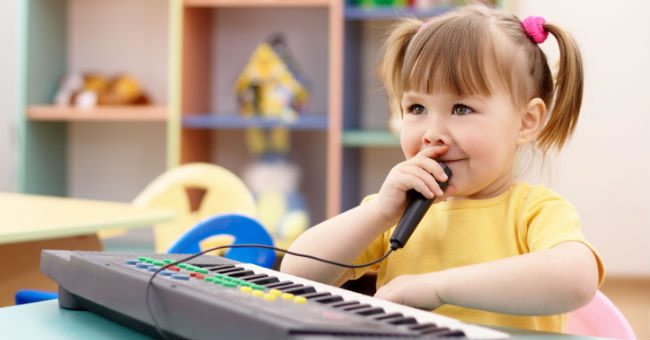
Music and movement are essential parts of early learning. From singing songs with children to having a variety of instruments in the music center, it's important that you create an environment that inspires children to express themselves and learn social and emotional skills, such as self-management. "In addition to arranging and equipping a music center where children explore and experiment with sound-making instruments, planned experiences and your guidance further encourage learning and creative expression," emphasizes Ann Barbour, PhD, in Play Today: Building the Brain Through Creative Expression. "The most important considerations should be ensuring that music and movement experiences are playful, interactive, and joyful." Here are six of the strategies Barbour shares in her book to help educators foster creative expression through music and movement:
- Play high-quality music. Top 40 songs, advertisement jingles, and movie or TV soundtracks are the types of music children frequently hear, but it often doesn't encourage them to really listen and interpret the music. Make it your goal to expand children's musical diets by introducing them to classical, jazz, or folk music and music from other cultures.
- Encourage active listening. Help children listen to (instead of just hear) pieces of music by asking them how it makes them feel or what it reminds them of. You can also encourage active listening by guiding children in sound explorations. Help them compare the loudness, pitch, and rhythm patterns of different sounds, or ask them how many sounds they can make with just their hands.
- Establish basic ground rules for self-management. Make sure children can recognize auditory and visual clues. For example, establish that when you stop the music, dim the lights, or shake a tambourine, it's time for them to stop moving or making music. You may want to use carpet squares or plastic hoops to define personal space as children explore music.
- Provide props. Simple props, such as scarves, hoops, balls, and stuffed animals, can help support children's creative movements. Make sure you help children practice ways to use props for movement before putting them out for independent use. Keep in mind that natural items or repurposed household materials can also be used as instruments and/or dance props.
- Join in. Don't let your role as teacher or caregiver stop you from joining in on the fun. Your active involvement in music and movement can help children express themselves more freely. You can always close your classroom door if it makes you feel more comfortable. Remember that children look up to you and will be eager to participate in the activity if you choose to participate as well.
- Include music and creative movement throughout the day. Incorporating music and movement throughout the day can help make your classroom a joyful place. You'll find that music and movement activities help ease transitions, enhance thematic studies, and much more.
Be sure to visit the Music and Audio/Visual section of our website to view our selection of musical instruments for children, music libraries and sets, CDs and videos for children, and additional materials.
